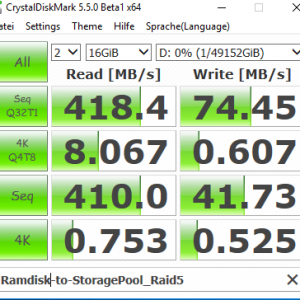Why there is no write speed gain when using a higher RAID level?
in Part 2 – Which RAID Level should I use? we talked about the different RAID levels, now the question is, which RAID level will be the perfect one for my application?
typical RAID Levels (commonly used) provide us with these fundamental rules:
Based on a disk array based on 8 drives (see sample here)
| RAID 0 | RAID 1 | RAID 5 | RAID 6 | RAID 10 | |
| minimum disks: | 2 | 2 | 3 | 4 | 4 |
| Speed gain READ: | 8x read | Up to 8x read | 7x read | 6x read | 8x read |
| Sped gain WRITE: | 8x write | no | no | no | 4x write |
| use: | High End Workstation, real-time applications | OS, databases | Data warehousing, web server, archiving | High End Workstations, real-time applications, transitory data, archiving | Fast databases, application servers |
| Data Protection: | no protection | Single-disk failure | Single-disk failure | Two-disk failure | single disk failure in each sub-array |
| Capacity utilization of all disks: | 100% | 50% | 66-94% | 50-88% | 50% |
As we see, a write speed gain appears only when using a RAID 0, an increased write performance can be used with RAID 10 as well.
Write speed gain is a fundamental factor when handling intermediate data.
 CrystalDiskMark Ramdisk to Single Drive |
 CrystalDiskMark Ramdisk to SSD |
 CrystalDiskMark Ramdisk to RAID0 |
 CrystalDiskMark Ramdisk to Storage Pool/Storage Spaces RAID 5 |
 CrystalDiskMark Ramdisk to JBOD |
 CrystalDiskMark Ramdisk to RAMDISK |
Continue with Part 4 – The Myth of Redundancy in Data Storage, where we will talk about the Question of Redundancy when using RAIDs.
